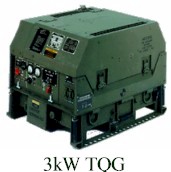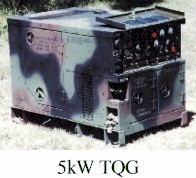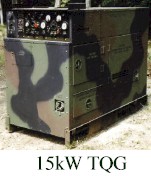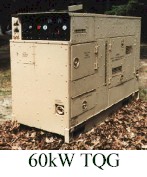





Libby Corporation 1993-1994 Kansas City, Missouri
Mr. Stitt used his vocational and university electronics background, along with 7 years experience developing OEM electronic commercial and consumer products as a Production Testing Engineer during the gulf war. His accomplishments included mastering all phases of production testing, calibration, sample testing, hot room testing, audio testing, computer analysis of voltage and harmonic, trouble shooting and repairing 10 different series of 3 phase generators built to military specifications. Sizes ranged from 5KW to 6OKW 50,60, and 400 Hz, voltage range 120/208 to 240/416 up to 150 amps per phase.
In a few months, he was promoted to 2nd shift Production Testing Supervisor. Controlling work activities to improve quality, problem solving, planning work activities, providing feedback to coworkers, creating and maintaining a positive work environment, career counseling, attending a supervisor training class where I was elected spoke person for a special project and delivered class project to the directors of Libby Corporation. Mr. Stitt employment lasted until the end of the Gulf War and Libby implemented a 25% across the board work force reduction based on seniority.
Tactical Quiet Generators
Changing requirements and maintainability problems with the MIL STDs led to a need for generators with greater mobility, improved reliability/maintainability, enhanced survivability (e.g., Electro - Magnetic Pulse (EMP)), reduced infrared and acoustic signatures and lower acquisition and operation and support (O&S) costs.
Thus in 1988 and 1989 the PM developed and released purchase descriptions for a new family of generators -- the Tactical Quiet Generators (TQG)s. Libby Corporation won the contract to develop the 5-60kW generators, and Fermont Division the 3kW TQG. In December 1993 the 5-60kW sets first entered service at Fort Bragg, NC in the 82nd Airborne Division, and fielding has continued ever since. Because the contractor was unable to meet the overly stringent performance requirements, the 3kW contract was terminated in February 1995. A replacement program began in February, 1996.
The Tactical Quiet Generators (TQGs) are the latest generation of military generators for use by the Armed Forces. They were developed in response to the changing military threats, new strategies, and fiscal constraints which dictated improved battlefield survivability, enhanced deployment/maintainability and reduced operating and support costs. These military generators use predominantly commercial components, and provide a "Quantum Leap" in performance for the Standard Family of DoD Generators.
The TQGs are skid or trailer mounted generator sets, are "single-fuel" compliant (operate on diesel/JP fuels), have radically improved survivability, mobility, reliability and maintainability (see the benefits chart). Noise has been reduced to 70 dbA or less, quiet enough to reduce detection ranges from over a mile to less than 400 meters. The sets are undetectable from the front and sides by ground or airborne FLIR. Weight and size has been reduced by 20%, improving mobility and deployment. Significant improvements (16-19%) were made in maintainability (MTBF) and serviceability (PMCS) -- reducing both cost and manpower support costs. Finally, reliability has improved by over 100%. Moreover, they have reduced overall life cycle costs through reduced acquisition costs, lower fuel consumption and reduce O&S costs. Actual sample data collection from fielded sets indicates an average Operational Readiness (OR) rate of 96-99% (depending on size). In Haiti, even under extreme operating and environmental conditions the new TQGs achieved an 89% readiness rate -- orders of magnitude better than the old MIL STDs.
Battlefield survivability has been markedly improved by reducing noise by 80%, virtually eliminating IR signatures, and by hardening them against Electromagnetic Pulse (EMP) effects. Mobility has been enhanced by reducing weight and size, and maintainability/support has been improved by doubling reliability which reduces Operations and Support (O&S) costs.
Additional funding placed in the Army power generation budget over the FY99-01 timeframe has helped to stem the continual aging of the fleet. However, considerably more funding will be necessary to reverse the aging of the fleet and accelerate the fielding completion.
As of mid-2001, winterization kits for the 5-60kW Tactical Quiet Generator (TQG) Family was under development. These kits will be available to units that require power in climates -25 deg F or below. Units will requisition individual kits by NSN and (kW) size. NSN assignment expected 4th QTR FY 99. Kit availability was expected for the 1st QTR of FY00.
Fielding of the 5 through 60kW generators began in December 1993. TQGs have been purchased and fielded by the Army, Air Force, Marine Corps, and several Allied Nations.
| Type | Nomenclature | Model # | Length | Width | Height | Applications |
|---|---|---|---|---|---|---|
| 3kW TQG | DED, 60 Hz | MEP-831A | 34.8 in. | 27.8 in. | 26.5 in. | Weapon Systems Missile Systems Causeway Systems C4I Systems |
| DED, 400Hz | MEP-832A | |||||
| 5kW TQG | 60 Hz TQG | 802A | 50.4 in. | 31.8 in. | 36.2 in. | Weapon Systems Missile Systems Causeway Systems C4I Systems |
| 400 Hz TQG | 812A | |||||
| 10kW TQG | 60 Hz TQG | 803A | 61.7 in. | 31.8 in. | 36.2 in. | Weapon Systems Missile Systems Laundry Units C4I Systems Refrigeration Systems |
| 400 Hz TQG | 813A | |||||
| 15kW TQG | 60 Hz TQG | 804A | 69.3 in. | 35.3 in. | 54.1 in. | Weapon Systems Missile Systems Well Kit, Printing Plants Topographic Support Systems C4I Systems Hospital Maintenance |
| 400 Hz TQG | 814A | |||||
| 30kW TQG | 60 Hz TQG | 805A | 79.3 in. | 35.3 in. | 54.1 in. | Weapon Systems Missile Systems Bakery Plant ADP Support Systems Water Purification C4I Systems Aviation Shop Sets |
| 400 Hz TQG | 815A | |||||
| 60kW TQG | 60 Hz TQG | 806A | 86.3 in. | 35.3 in | 58.2 in. | Weapon Systems Missile Systems Earth Satellite Terminals Field Hospitals/Schools Aviation Ground Support |
| 400 Hz TQG | 816A |